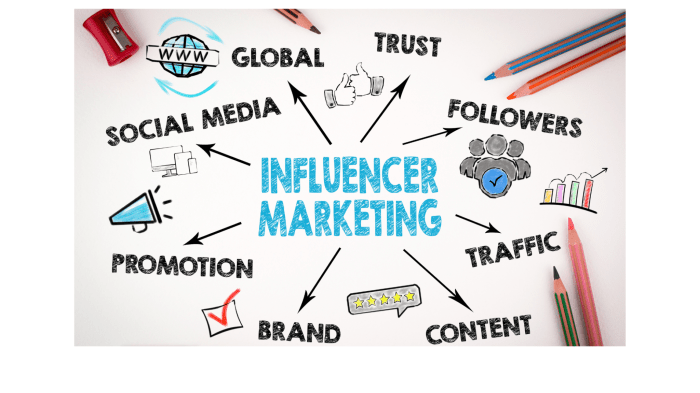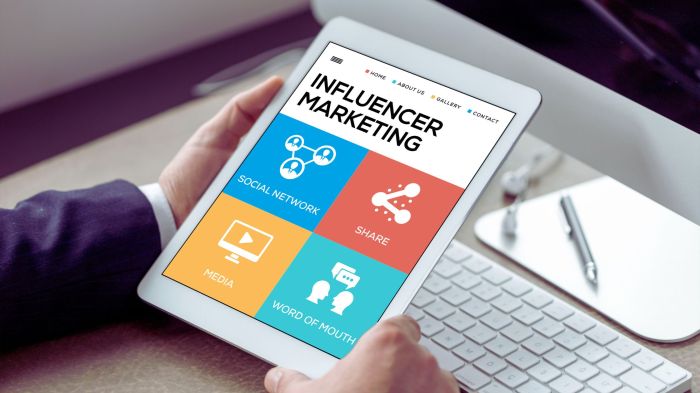Building an Influencer Marketing Campaign kicks off with a bang, giving you the lowdown on how to captivate your audience and boost your brand’s presence. From identifying your target audience to collaborating with influencers, this guide covers it all.
Introduction to Influencer Marketing Campaign: Building An Influencer Marketing Campaign

Influencer marketing campaigns involve partnering with individuals who have a strong following on social media to promote a brand or product. These influencers use their platform to endorse products or services to their audience.Influencer marketing is important for businesses because it allows them to reach a larger and more targeted audience. By partnering with influencers who have a loyal following, businesses can increase brand awareness, credibility, and ultimately drive sales.
Examples of Successful Influencer Marketing Campaigns
- Kylie Jenner partnering with brands like Fashion Nova and Adidas to promote their products to her millions of followers.
- Dove’s campaign with real women influencers promoting body positivity and self-love, which resonated with their audience and went viral.
- Daniel Wellington’s collaboration with fashion influencers on Instagram, showcasing their watches in lifestyle posts, leading to a significant increase in sales.
Identifying Target Audience
Identifying the target audience is crucial for the success of an influencer marketing campaign. By understanding who your audience is, you can tailor your content and choose the right influencers to reach them effectively.
Methods to Identify Target Audience
- Conduct market research to gather data on demographics, interests, and behavior of your target audience.
- Utilize social media analytics tools to analyze the followers of potential influencers and identify common traits.
- Create buyer personas to represent different segments of your target audience and tailor your campaign accordingly.
Importance of Understanding Target Audience
Understanding the demographics and interests of your target audience allows you to create content that resonates with them. It helps in crafting messages that are relevant and engaging, increasing the chances of a successful campaign.
Matching Influencers with Target Audience
- Look for influencers whose followers match your target audience based on demographics, interests, and values.
- Consider the engagement rate of influencers with their followers to ensure authenticity and trustworthiness.
- Collaborate with influencers who have a genuine connection with your target audience to maximize the impact of your campaign.
Setting Campaign Goals

Setting clear goals for an influencer marketing campaign is crucial for its success. It helps in providing direction, measuring progress, and evaluating the effectiveness of the campaign. Without clear goals, it becomes challenging to determine the ROI and impact of the campaign on the overall marketing strategy.
Importance of Setting Clear Goals
- Allows for better planning and strategizing
- Helps in measuring success and ROI
- Ensures alignment with overall marketing objectives
Common Campaign Goals
- Brand Awareness: Increasing visibility and recognition of the brand among the target audience.
- Lead Generation: Generating potential leads or prospects for the business.
- Sales: Driving sales and revenue for the products or services being promoted.
Aligning Campaign Goals with Marketing Objectives
Setting campaign goals that align with the overall marketing objectives is essential for a cohesive and integrated marketing strategy. It ensures that the influencer marketing efforts are contributing towards the broader goals of the business. Here are some key steps to align campaign goals with marketing objectives:
- Understand the overall marketing objectives of the business
- Identify how influencer marketing can support these objectives
- Set specific and measurable goals that are in line with the marketing strategy
- Regularly track and analyze the performance of the campaign against these goals
Choosing the Right Influencers
When selecting influencers for a marketing campaign, it is crucial to consider certain criteria that align with the brand and campaign goals. The right influencers can help reach the target audience effectively and create authentic engagement.
Types of Influencers, Building an Influencer Marketing Campaign
- Nano influencers: These influencers have a smaller but highly engaged audience. They are known for their niche expertise and personal connection with their followers.
- Micro influencers: With a slightly larger following than nano influencers, micro influencers have a strong influence on their audience within a specific niche.
- Macro influencers: These influencers have a significant following, often ranging from 100k to 1 million followers. They have a broader reach and can appeal to a wider audience.
- Mega influencers: Mega influencers have a massive following, usually in the millions. They are popular figures such as celebrities or well-known personalities.
Vetting Influencers for Authenticity and Engagement
When vetting influencers, it is essential to look beyond their follower count and consider factors like engagement rates, audience demographics, and content quality. Here are some tips to ensure authenticity and engagement:
- Review their past collaborations and content to see if it aligns with your brand values.
- Check their engagement rates, likes, comments, and shares to gauge the level of interaction with their audience.
- Look at the demographics of their followers to ensure they match your target audience.
- Consider conducting a trial campaign or test collaboration before committing to a long-term partnership.
Collaborating with Influencers
Building strong relationships with influencers is crucial for the success of your marketing campaign. Here are some strategies to consider when collaborating with influencers:
Building Relationships with Influencers
- Engage with influencers on social media: Like, comment, and share their content to show your support and build rapport.
- Attend events: Meet influencers in person at industry events or brand activations to establish a personal connection.
- Offer value: Provide influencers with exclusive access, sneak peeks, or other perks to make them feel appreciated and valued.
Negotiating Terms, Contracts, and Compensation
- Clearly Artikel expectations: Set clear goals, deliverables, and timelines in the contract to avoid any misunderstandings.
- Be flexible: Negotiate terms that work for both parties, such as payment, creative control, and exclusivity agreements.
- Consider long-term partnerships: Building a long-term relationship with an influencer can lead to more authentic content and better results.
Creating Authentic Content
- Encourage creativity: Allow influencers creative freedom to develop content that resonates with their audience while promoting your brand.
- Align brand values: Ensure that the influencer’s content aligns with your brand values and messaging to maintain authenticity.
- Provide guidance: Offer guidance and feedback to help influencers create content that meets your campaign objectives while staying true to their style.
Monitoring and Measuring Campaign Performance
Influencer marketing campaigns require continuous monitoring and measurement to ensure their success. By tracking key performance indicators (KPIs) throughout the campaign, businesses can assess the effectiveness of their strategies and make necessary adjustments to improve results.
Importance of Tracking KPIs
Monitoring KPIs is crucial as it provides valuable insights into the campaign’s performance and helps in evaluating the return on investment (ROI). Key metrics such as engagement rates, click-through rates, conversion rates, and overall reach can indicate how well the campaign is resonating with the target audience. By tracking these KPIs, businesses can identify strengths and weaknesses in their influencer marketing efforts and optimize their strategies accordingly.
- Engagement Rates: This metric measures the level of interaction and interest generated by the influencer’s posts. High engagement rates indicate that the content is engaging and resonating with the audience.
- Click-through Rates: Tracking the number of clicks on the influencer’s call-to-action links can help assess the effectiveness of driving traffic to the brand’s website or landing page.
- Conversion Rates: By monitoring how many leads or sales are generated as a result of the campaign, businesses can determine the campaign’s impact on driving conversions.
- Overall Reach: Understanding the reach of the influencer’s posts can give insights into the campaign’s visibility and potential audience reach.
Consistently tracking KPIs allows businesses to make data-driven decisions and optimize their influencer marketing campaigns for better results.
Tools and Metrics for Monitoring Success
There are various tools and metrics available to help businesses monitor the success of their influencer marketing campaigns. Popular tools like Google Analytics, social media analytics platforms, and influencer marketing software can provide valuable data on campaign performance. Metrics such as impressions, likes, shares, comments, and follower growth can offer insights into audience engagement and campaign reach.
| Tool/Metric | Description |
|---|---|
| Google Analytics | Tracks website traffic, referral sources, and conversions driven by influencer marketing campaigns. |
| Social Media Analytics | Provides data on post performance, audience demographics, and engagement metrics on social media platforms. |
| Influencer Marketing Software | Helps manage influencer relationships, track campaign performance, and analyze ROI. |
Analyzing Data and Adjusting Strategies
After collecting data from tracking KPIs and using relevant tools and metrics, businesses need to analyze the results to gain insights into campaign performance. By identifying patterns, trends, and areas for improvement, businesses can adjust their strategies for better outcomes. This may involve reallocating resources, refining content, collaborating with different influencers, or targeting new audience segments based on the data analysis.
- Regularly review KPIs and metrics to assess campaign progress and identify areas needing improvement.
- Compare performance against set goals and benchmarks to measure success and make informed decisions.
- Iterate on strategies based on data analysis to optimize campaign performance and achieve desired outcomes.
